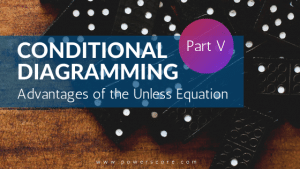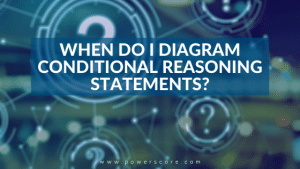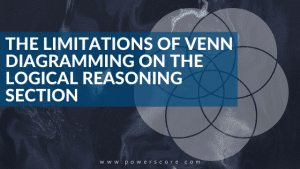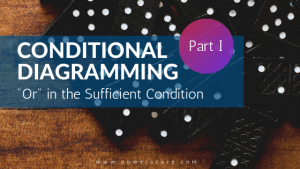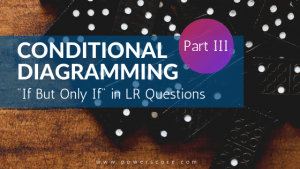Diagramming and notation can play a vital role in a strong performance on the Reading Comprehension section of the LSAT. The ideal approach to effectively breaking down the passages, however, can be different for each student. Unlike Logic Games, when it comes to Reading Comprehension passages there is no single best way to diagram or notate. There are, however, several diagramming options from which to choose. Basic Underlining This is the … [Read more...]
Diagramming on the LSAT Part II – Notation Suggestions
In the first part of this series, I address LSAT diagramming and how to better determine its usefulness for you. Essentially, I suggest that diagramming is an investment of your time and rhythm. In order for that investment to be worthwhile, it needs to pay dividends in terms of two things:Gaining you more time than it took as you continue on. Like a prephrase, where you can more aggressively/efficiently sort through the answers. Leading … [Read more...]
Diagramming on the LSAT Part I: Is It Worth It?
When time is running out, students face a critical dilemma. It's one that I feel is important to briefly address as it is one of the most common elements that students find slows them down: diagramming. Make Sure It's Worth Your Time Here's the thing. Any time you find yourself stopping to make notations, for a passage, game, or stimulus, you're using valuable time. Theoretically, that time may be better spent. Maybe by continuing to … [Read more...]
Conditional Diagramming Part V: Advantages of the Unless Equation
Students often ask if there is an easier way to handle conditional statements containing necessary condition indicators such as “unless,” “except,” “until,” and “without.” The Unless EquationTM This is relatively simple, but it does involve a two-step process:Whatever term is modified by “unless” becomes the necessary condition. The remaining term is negated and becomes the sufficient condition.For example, consider the … [Read more...]
Conditional Diagramming Part IV: Working with “Only”
We are continuing our Conditional Diagramming discussion today with the word “only” which is used frequently in LSAT questions. “Only” is a necessary condition indicator, and its usage is often easy to parse. Here’s an example: Only doctors carry malpractice insurance. “Only” modifies “doctors,” and thus the proper diagram is: Carry malpractice insurance → doctor However, in a number of instances, “only” is used in a way that is more … [Read more...]
When Do I Diagram Conditional Reasoning Statements?
A question that frequently comes up from readers of the LSAT Logical Reasoning Bible is, when should I diagram conditional statements in the LSAT Logical Reasoning section? In the book, I talk about diagramming in a number of different chapters, but most prominently in the chapter on Conditional Reasoning.Conditional Reasoning is a Major Concept While, not surprisingly, I think that every chapter in the LR Bible has high value, the … [Read more...]
The Limitations of Venn Diagramming on the Logical Reasoning Section
This post is from the LSAT Free Help Area on our website. Want to get even more free LSAT help? Check it out! While preparing for the LSAT, students will undoubtedly encounter a wide variety of suggested test taking strategies. Unfortunately, one of the more commonly advocated approaches, particularly with regards to the Logical Reasoning sections, is the use of Venn diagrams1. Despite their popularity with certain test-preparation programs, … [Read more...]
Conditional Diagramming Part II: “And” in the Necessary Condition
In my last post, I discussed conditional statements with "or" in the sufficient condition. Diagrams with multiple necessary conditions can, depending on the circumstances, then be used to create multiple single diagrams. Let's look at an example.If the rule reads: "If Operations is offered, then Accounting or Sales is also offered," then the diagram is solely: A O → or S Because the necessary condition is just at least … [Read more...]
Conditional Diagramming Part I: “Or” in the Sufficient Condition
Diagrams with multiple sufficient conditions can, depending on the circumstances, then be used to create multiple single diagrams. Let's look at an example.Consider a rule that reads: "If Operations or Sales is offered, then Accounting is also offered." Operations = O Sales = S Accounting = A As a single conditional statement, there are two parts to the sufficient condition (O and S), that are joined by an "or" operator. That sufficient … [Read more...]
Conditional Diagramming Part III: “If But Only If” in LR Questions
An interesting topic came up on our forum a short time back, about the meaning of “If but only if,” and the proper way to diagram a rule that includes this phrase. Students who are familiar with the LSAT have probably encountered a rule that says “if and only if,” but the use of the term “but” is a clever trick by the test makers. “If but only if” doesn’t look quite the same as “If and only if,” and to many students, the two phrases appear to … [Read more...]




